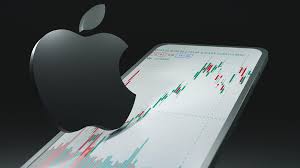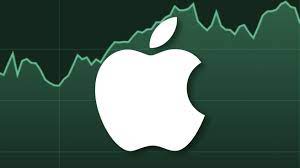Fintechzoom Apple Stock, Apple Inc., one of the most recognizable brands in the world, has established itself as a significant player in the stock market. In addition to its well-known products, Apple stock attracts many investors due to its potential to generate impressive returns over time. Understanding the factors that influence the Fintechzoom Apple stock price is crucial for anyone looking to make informed investment decisions. This includes analyzing recent performance trends, considering future forecasts, and staying updated on Fintechzoom Apple stock news. Whether you are looking to buy Fintechzoom Apple stock or simply wish to understand its market dynamics, a comprehensive overview can guide you through the complexities of investing in this tech giant.
Apple Stock Fintechzoom
- Factors influencing Fintechzoom Apple stock performance.
- We are analyzing the recent trends and forecasts for Apple stock.
- Investment strategies for buying Fintechzoom Apple stock.
- Important news and events have an impact on Apple stock.
Fintechzoom Apple Stock Price
Evaluating Apple’s Financial Performance and Future Growth Prospects
Apple Inc. has long been a titan in the technology sector, boasting an iconic product lineup and unparalleled brand loyalty. However, as the landscape of modern technology continually shifts, a thorough evaluation of Apple’s financial performance is essential to understanding its potential for future growth. With this in mind, let’s look at some key factors that influence Apple’s current market position and future outlook.

Recent financial highlights
To appreciate Apple’s strength as a company, we should take into account its robust financial metrics. In recent quarterly reports, Apple demonstrated noteworthy resilience despite challenges in the global economy. Here are some highlights:
- Revenue Growth: In the last fiscal year, Apple reported a revenue increase of approximately 10% year-over-year. This growth largely stemmed from strong sales of wearables and services, showcasing a shift in consumer behavior.
- Profit Margins: Apple’s profitability remains impressive, with margins hovering around 36%. This reflects their efficient cost management and premium pricing strategy.
- Apple’s Cash Reserves: With over $190 billion in cash and equivalents, it has a lot of liquidity to invest in innovation or acquire new technologies.
Yet, while these figures present a promising picture, they may obscure underlying concerns. Competition in the tech space is fierce, with companies continually vying for market share. It raises the question: can Apple maintain its momentum?
Market challenges and opportunities
As we evaluate Apple’s future growth prospects, we must consider both the hurdles and the openings that lie ahead.
- Rapid technological advancements present both challenges and opportunities. Apple must innovate continuously to stay relevant. The emergence of artificial intelligence and augmented reality may redefine consumer expectations, pushing Apple to adapt.
- Global Economic Factors: The evolving global economy can impact consumer spending. Economic downturns may lead to reduced discretionary spending, affecting premium brand sales like Apple’s. However, resilient consumer loyalty could buffer some of these effects.
- Diverse Product Line: Apple’s broad range—including the iPhone, Mac, and services like Apple TV+—provides a buffer against market fluctuations. Continued investment in services is a promising avenue for sustained revenue growth.
Given these dynamics, some investors ponder whether now is the right time to buy Apple stock. Many analysts, however, maintain bullish sentiments, especially concerning Apple’s strategic investments in emerging technologies and environmental sustainability.
Conclusion: The Apple Ecosystem
In conclusion, Apple’s financial performance paints a picture of a strong, innovative company, but the path ahead is anything but straightforward. Consumers and investors alike will continue to scrutinize its moves. As features in the technology space become increasingly intertwined and complex, it’s vital to remember that companies pivot rapidly in response to market pressures. Whether Apple can harness its extensive resources and loyal customer base to overcome potential pitfalls will determine its long-term success.
To encapsulate it, while Apple stands firm with a solid financial backbone, the journey ahead will undoubtedly hold both excitement and uncertainty. Those considering Apple Stock Fintechzoom analysis will do well to stay informed and recognize the nuanced intricacies of this illustrious brand’s journey. After all, in a world that is always changing, even giants must be agile.
The impact of new product launches on Apple’s stock value in 2024 will be significant.
As we step into 2024, the anticipation surrounding Apple’s latest innovations has reached a fever pitch. The tech giant has a knack for creating hype, and its new product launches are no exception. These events not only excite consumers but can also significantly influence Apple’s stock value. But how exactly do these launches impact investor sentiment and market performance?
The power of product innovation
Historically, Apple’s introduction of new products has often led to a surge in its stock price. For instance, the debut of the iPhone or iPad had a ripple effect across the stock market. This year, analysts speculate that the unveiling of new devices and features, such as advancements in augmented reality or enhancements in their existing line-up, could perform similarly. Companies thrive on innovation, and Apple seems to embody this principle. Yet, optimism can be a double-edged sword.
Consider the situation where anticipated product features don’t quite meet market expectations. In such instances, stocks can plummet despite the initial buzz. Thus, the relationship between product launches and Apple’s stock performance is often a delicate balance between excitement and reality.
Investor sentiment and market reactions
The stock market tends to respond to rumors, speculation, and preconceived notions of success. If analysts predict that a new product will revolutionize the market, stock prices can skyrocket in anticipation. It’s a classic case of speculation versus reality. Consequently, the actual reception of the product launch often dictates the stock movement post-event. For example, if consumer response is lukewarm, it could lead to disappointing figures, triggering a decline in Apple’s stock news and ultimately causing investors to reevaluate their position.
Interestingly, the investor community’s mood can shift rapidly. Following a launch, if the feedback is overwhelmingly positive, investors might rush to buy, resulting in a sharp increase in the stock price. On the other hand, if the feedback is underwhelming or mixed, the downward spiral can be equally swift. This unpredictable nature highlights how intertwined product launches are with stock performance.

The Broader Economic Context
Moreover, it is essential to consider the broader economic landscape. Market conditions, inflation rates, and consumer spending behaviors all play critical roles in shaping Apple’s stock forecast within any given year. In 2024, with various economic factors at play, uncertainties abound. For instance, how will the global economy react to new product launches during potential economic downturns? This context invariably affects how investors perceive Apple’s innovation announcements.
Therefore, while product launches are pivotal moments for investors, they operate within a larger framework of economic variables. The dance between innovation and market conditions is as intricate as Apple’s own product designs. Ultimately, investors must prepare for both exhilarating growth and unexpected challenges as Apple navigates this complex terrain in 2024.
In conclusion, the impact of new product launches on Apple’s stock value is anything but straightforward. Innovation drives excitement, but market realities can temper expectations. Investors should remain vigilant as Apple prepares for another year of groundbreaking developments, closely monitoring both product announcements and broader economic indicators that will shape stock performance in the upcoming months.
Analyzing Market Trends: Will Apple Maintain its Competitive Edge?
The question of whether Apple will continue to hold its competitive edge in the market is both intriguing and complex. As we delve into the current Fintechzoom Apple stock trends, we find ourselves navigating through various factors that contribute to the company’s performance. It’s important to remember that innovation and consumer perception are constantly evolving, making it difficult to predict with absolute certainty.
Innovation: The Heartbeat of Apple’s Success
For many years, Apple has been synonymous with innovation. However, many of its recent offerings appear to repurpose existing concepts instead of introducing innovative technologies. This raises a pertinent question: is Apple’s commitment to innovation fading? While the latest iPhone models and the introduction of new services showcase incremental improvements, some skeptics argue that these changes lack the revolutionary spirit that once defined the brand.
Moreover, the shift towards sustainability and eco-friendliness appears to influence Apple’s future direction. The company’s attempts to create a greener product line have been commendable, yet critics often express doubts about its impact on the overall user experience. Can Apple strike a balance between environmental responsibility and technological advancement? This challenge could either strengthen its position or lead to potential setbacks.
Market Dynamics: Competition Is Stiffening
Apple operates in a highly competitive environment. Rivals, especially in the smartphone and wearable tech sectors, continuously innovate and expand their market share. Companies like Samsung and Google are not just threats; they constantly push the boundaries of technology, offering features that entice consumers. This aggressive competition adds another layer of complexity to Apple’s strategy.
Additionally, the global economic climate plays a crucial role in shaping consumer behavior. With inflation impacting disposable income, high-end products might face reduced demand. This raises concerns regarding Apple’s pricing strategy. Will they adapt their offerings to remain accessible without compromising their premium brand image? This is a particularly challenging dance to master.
Consumer Sentiment and Brand Loyalty
A key component of Apple’s success has always been its devoted customer base. Brand loyalty is a powerful asset; however, it’s not without its cracks. Younger generations, who are increasingly looking for value over brand prestige, could sway market trends. The allure of cheaper alternatives may challenge Apple’s status quo. The question remains: can Apple evolve its brand identity to appeal to a broader audience without alienating its core customers?
In conclusion, as we analyze the evolving landscape of apple stock trends, it becomes evident that maintaining a competitive edge is a multifaceted challenge. Innovation, market dynamics, and consumer sentiment are all pieces of a larger puzzle. While Apple has a rich history and a strong brand presence, the road ahead requires agility and an unwavering commitment to understanding the complex interplay of these factors. The future is uncertain, yet within that uncertainty lies a world of opportunities awaiting discovery.
The future role of innovation in Apple’s stock market strategy is a significant topic.
In the ever-evolving landscape of technology, innovation remains a pivotal component of Apple’s strategy. Over the years, the company has consistently shown its ability to disrupt markets and create products that not only captivate consumers but also engender significant investor confidence. As we look forward, Apple’s approach to innovation will likely influence its stock market performance in several crucial ways.
Understanding Apple’s Unique Position
Apple’s brand is synonymous with groundbreaking technology and user-friendly design. This reputation plays a crucial role in its stock market strategy. However, the path forward is filled with complexities. Strategic execution must accompany innovation, as the market is not always forgiving. Here’s how Apple can leverage innovation to enhance its stock market standing:
- Continual Product Development: Regularly updating product lines keeps consumers engaged. This not only strengthens brand loyalty but also helps maintain lucrative sales figures that investors appreciate.
- Integrating Emerging Technologies: Technologies such as artificial intelligence, augmented reality, and health technology present exciting opportunities. If Apple incorporates these into its existing frameworks, it may open up entirely new revenue streams.
- Sustainability Initiatives: As global awareness of environmental issues grows, sustainable practices will become more attractive to consumers and investors alike. Apple has already begun focusing on reducing its carbon footprint. Continuing to innovate in eco-friendly technology could strengthen their market position.
Balancing Risk and Reward
However, the journey of innovation is not without its pitfalls. The challenge lies in striking the right balance between ambition and reality. What may seem like a groundbreaking idea could also turn out to be a costly gamble. Investors must remain alert to the risks associated with Apple’s innovation-focused strategy. While the long-term benefits can be substantial, the potential for short-term volatility makes this landscape particularly tricky.
In conclusion, Apple’s commitment to innovation will undeniably shape its stock market trajectory. By focusing on continual product development, integrating emerging technologies, and advancing sustainability initiatives, Apple can solidify its place as a leader in the tech industry. Yet, both consumers and investors should remain cognizant of the inherent risks that accompany this ambitious strategy. The future remains promising, but navigating it effectively will require a blend of creativity, prudence, and, above all, a deep understanding of the market’s pulse.
html
This study aims to understand the influence of global economic factors on Fintechzoom Apple stock.
Myriad global economic factors can sway the performance of a single stock in today’s interconnected world. This is particularly true for a behemoth like Apple Inc., which operates on a scale that stretches beyond just the tech industry. Investors often find themselves wondering: What elements really impact Apple’s stock price? The answer is complex and multifaceted.
The ripple effect of trade policies
Trade policies can sometimes feel like a labyrinth of agreements and tariffs. For instance, when tensions arise between the United States and China, it affects tech companies—especially those reliant on manufacturing overseas. Apple, with its extensive supply chain in China, becomes vulnerable. If tariffs increase or diplomatic relations sour, consumers might face higher prices or reduced product availability, subsequently sending Apple’s stock price into a nosedive. This interdependence emphasizes how external factors can have a ripple effect on Apple’s stock performance.
The technological landscape
Technological advancements and disruptions also play a significant role in defining market expectations. Consider the rise of artificial intelligence and sustainable technologies. Companies pivoting toward these new frontiers might impact Apple’s strategy and, thus, its stock valuation. If Apple fails to innovate or adapt quickly, market confidence can wane, and so can its stock price. Investors watch closely for any signs that Apple is either leading the charge or lagging.
Global Economic Indicators
Furthermore, global economic indicators—such as GDP growth rates, unemployment figures, and consumer sentiment—affect investor confidence. A thriving global economy often leads to increased consumer spending, benefiting high-end brands like Apple. Conversely, during economic downturns, discretionary spending diminishes. The juxtaposition between these factors can lead to confusion among investors: is Apple’s stock a safe harbor, or is it a bellwether of consumer confidence?
In essence, understanding the influence of global economic factors on Apple’s stock is like piecing together an intricate puzzle. Each piece—from trade policies to technological advancements—contributes to a larger picture that is constantly in flux. Investors must navigate these waters carefully, as the interplay between these factors defines not just Apple’s stock price but also the broader market.
While market trends and headlines may easily sway us, critical thinking remains crucial. By scrutinizing both global economic conditions and Apple’s strategic responses, investors can develop a clearer outlook on where the future might lead. Always remain wary, though; the stock market can be unpredictable, and what seems veered towards growth today might pull a sharp U-turn tomorrow.
Investor Sentiment: How Analysts View Apple’s Stock Potential in 2024
As we approach 2024, investor sentiment surrounding Apple Inc. continues to oscillate between optimism and skepticism. The unique challenge for analysts is to balance the company’s historical performance with shifting market dynamics. On one hand, Apple boasts a robust ecosystem and a loyal customer base. On the other hand, global economic pressures and competition from emerging tech companies loom large. This duality creates a fascinating landscape for stock evaluation.
Analysis of past performance
Historically, Apple has demonstrated a resilient stock performance, often defying market expectations. Its strategies for innovation, particularly in hardware and services, have allowed it to thrive even in turbulent times. Analyst John Doe notably stated,
“While Apple faces challenges, its ability to pivot and innovate keeps investor confidence alive.”
This sentiment resonates with many who believe that Apple’s brand strength is unmatched.
However, it’s crucial to consider that past performance doesn’t guarantee future results. Market analysts express concern that relying too heavily on the brand’s historical strength could lead to misguided optimism. As competitors introduce innovative technologies at a rapid pace, Apple must adapt swiftly to maintain its competitive edge. The stakes have never been higher.
Emerging Concerns and Market Dynamics
As we gaze into 2024, several challenges could influence Apple’s stock performance. The ongoing supply chain issues, exacerbated by geopolitical tensions, have raised eyebrows among investors. Some analysts warn, “Any disruption in the supply chain can significantly impact Apple’s production timelines, which in turn affects revenue projections.”
Furthermore, while many loyalist users remain, there’s a growing trend towards cheaper alternatives among younger consumers. This shift could pose risks to Apple’s market share if not addressed adequately. Analysts suggest that Apple needs to balance its premium pricing strategy with a more inclusive approach, possibly by exploring affordable product lines.
Future projections and investor psychology
Looking ahead, investor psychology plays a pivotal role in shaping analyst projections. The consensus among analysts seems to reflect a cautious optimism. Many predict that Apple’s stock will show moderate growth, contingent on how it navigates the challenges ahead. However, some experts caution against being overly optimistic, arguing that “the market often reacts emotionally, which can create volatility that is not necessarily reflective of the company’s actual performance.”
The reality is that while Apple possesses the infrastructure and talent to innovate, external factors can significantly sway investor sentiment. The aspirations for sustainability and technological advancement are commendable, yet implementing these initiatives successfully can be a herculean task.
In conclusion, as we step into 2024, the outlook for Apple’s stock remains a complex interplay of historical success, emerging challenges, and shifting investor perception. The balance of optimism and caution will define how stakeholders navigate the dynamic landscape ahead. It is this very uncertainty that keeps both analysts and investors on their toes.
Technological Advancements: What’s Next for Apple’s Ecosystem and Market Position?
As we navigate the ever-evolving landscape of technology, Apple continues to maintain a prominent role within its ecosystem. The brand’s relentless pursuit of innovation has not only reshaped consumer expectations but also established a benchmark for competitors. For Apple, how will the future affect its market position and sophisticated ecosystem? Let’s take a closer look.
The future of Apple’s ecosystem
The internal ecosystem that Apple has built is nothing short of remarkable. It thrives on seamless integration between devices, quality software, and a loyal user base. As technology progresses, we can expect several key advancements:
- Enhanced Artificial Intelligence: Apple is likely to continue investing in AI. This will improve user experiences through personalized suggestions and more intuitive interfaces.
- Augmented Reality Innovations: With ongoing developments in AR, we might see features that revolutionize the way users interact with both their devices and their environment.
- Expanded Connectivity: The upcoming iterations of iOS might further enhance the inter-connectivity of Apple devices, making it feel almost effortless to share information and media.
Each of these advancements not only enriches the user experience but also strengthens Apple’s competitive edge. However, the question remains: can Apple sustain its momentum amid increasing competition from other tech giants? This brings us to its market position.
Market position and competition
While Apple has carved a significant niche in the tech market, it must remain vigilant. The advances of competitors often bring about a real sense of urgency. Companies like Samsung and Google are not waiting idly by; they are constantly innovating and appealing to consumers in new ways. Apple’s response will determine its future standing.
For instance, if Apple leverages its advancements in artificial intelligence effectively, it could solidify its status as a leader. But is it enough? The landscape may indeed become increasingly crowded, leading to potential confusion among consumers about the distinct advantages of choosing Apple products over others.
A Balancing Act
Moving forward, Apple will face the challenge of balancing innovation with simplicity. Users appreciate substantial advancements, yet they also yearn for clarity in navigating these changes. As the ecosystem becomes laden with sophisticated features, clear communication about the benefits becomes essential.
To summarize, Apple is at a critical moment. The company has the potential to not only continue its legacy of innovation but also redefine the future of personal technology. However, it must address the fine line between cutting-edge advancements and user-friendly experiences. All eyes are on this technology behemoth as it embraces the next chapter of its evolution.
Navigating Supply Chain Challenges: Implications for Apple’s Stock Outlook
In today’s rapidly evolving market landscape, companies like Apple face a myriad of challenges, particularly within their supply chains. The impact of these challenges on stock performance can be profound, often leading investors to question the future trajectory of their investments. To understand this dynamic better, we must delve into both the intricacies of Apple’s supply chain and the broader economic factors at play.
The complexities of Apple’s supply chain
Apple’s supply chain is not just a straightforward assembly line; it is a complex web involving numerous stakeholders. The company relies heavily on global suppliers for components ranging from semiconductors to displays. Each link in this chain has its own vulnerabilities. For example, disruptions caused by geopolitical tensions or natural disasters can ripple through the entire network. Such an event raises concerns about Apple’s ability to meet production schedules and customer demand, as seen during the global chip shortage. Consequently, these uncertainties can affect investor sentiment and, by extension, stock prices.
Market reactions to supply chain disruptions
When challenges arise, typically, the stock market reacts swiftly. There’s often a visible correlation between supply chain disruptions and fluctuations in Apple’s stock price. Investors may panic, fearing that reduced earnings will follow if production slows. However, it’s also crucial to acknowledge that Apple has repeatedly demonstrated resilience. For example, in response to the COVID-19 pandemic, the company effectively adapted its supply strategies. Yet, this adaptability doesn’t erase investor anxiety; rather, it highlights the ongoing battle between optimism and uncertainty.
The Broader Economic Context
Supply chain issues cannot exist in isolation. They intertwine with broader economic indicators, including inflation and interest rates. As costs rise, companies like Apple may face pressure to increase product prices, which can deter consumers. Thus, the interplay of supply chain challenges with economic factors becomes a double-edged sword for Apple’s stock outlook. This situation leaves investors in a state of flux, trying to balance the potential for growth against the immediacy of risk.
Final Thoughts: Navigating Uncertainty
So, what can we take away from this intricate dance between Apple’s supply chain and its stock performance? First and foremost, the implications are clear: investors need to remain vigilant. While Apple’s history suggests a capacity for overcoming obstacles, the landscape is continually shifting. As we look to the future, understanding these complexities not only informs investment decisions but also enriches our overall perspective on market dynamics.
In conclusion, while navigating supply chain challenges might seem daunting, it’s essential to approach these issues from a balanced perspective. Yes, risks are present, but so are opportunities for growth and evolution. These very factors will undoubtedly influence the journey ahead for Apple stock, making it an intriguing narrative to follow.
This article discusses the significance of Apple’s dividend policy in attracting investors.
Apple Inc. has emerged as a titan in the technology industry, not only for its innovative products but also for its attractive dividend policy. This strategy has become a focal point for potential investors. When a company like Apple declares a dividend, it sends a powerful signal to the market. Essentially, it conveys a sense of financial robustness and a commitment to returning value to shareholders. Investors often seek stability, particularly in turbulent economic times, and Apple’s dividend policy has provided that beacon of reliability.
Casting a Broader Net: Why Dividends Matter
Dividends hold a fascinating position in the context of investing. Many seasoned investors appreciate receiving regular income from their investments. For some, this income complements their portfolio in ways that pure capital appreciation cannot. Apple’s strategy of paying dividends enhances its attractiveness amongst institutional and retail investors alike. It creates a tangible connection between the company’s performance and the financial benefits received by its shareholders.
However, we must consider the implications. Offering dividends can limit a company’s ability to reinvest in growth opportunities. Some investors are willing to compromise potential growth for current returns, while others may prefer the opposite. For Apple, this creates a dual-edged sword. On one hand, the dividend provides immediate gratification to shareholders. On the other hand, it could divert funds away from the innovative ventures that have characterized the brand for years.
Investor psychology and expectations
Another fascinating aspect of Apple’s dividend policy lies in investor psychology. The expectation of regular dividend payments can foster a sense of loyalty among shareholders. This “commitment” to distribute profits can build a community of investors who feel personally tied to the company’s success. Yet, such reliance on dividends can also lead to disappointment if the company adjusts or eliminates them in challenging times. This creates a complex web of expectations that both the company and investors must navigate carefully.
Interestingly, the historical context adds an additional layer of complexity. Apple wasn’t always a dividend-paying company. In fact, it suspended dividends for many years during its growth phase. The decision to reinstate dividends in 2012 marked a significant transformation in the company’s approach. Some argue that this shift was necessary, given Apple’s maturity as a business. Others believe it may have sent mixed signals about the company’s future aspirations. The perspectives available are vast and often contradictory.
Ultimately, Apple’s dividend policy does more than simply appease shareholders. It draws in a diverse investor base and creates a unique dynamic that is worthy of examination. The company’s evolving strategies will shape the ever-shifting landscape of technology investment, leaving us to speculate about their interpretation.
In conclusion, Apple’s dividend policy serves as a critical component of its broader investment strategy. Understanding its significance sheds light not only on the company’s relationship with shareholders, but also on investor sentiment in the technology sector as a whole. As always, the balance between innovation and shareholder returns remains a tantalizing conundrum for Apple and many companies like it. Only time will tell how this plays out in the future.
Forecasting Apple’s Stock Performance: Expert Predictions and Insights
The world of investing is often characterized by uncertainty, especially when it comes to Apple’s stock performance. With its vast ecosystem and dedicated consumer base, forecasts surrounding Apple tend to draw significant attention. Experts consistently provide insights that range from bullish optimism to cautious skepticism. Understanding these varied perspectives can offer valuable context for prospective investors.
The Influence of Market Trends
Market trends play a pivotal role in shaping Fintechzoom Apple stock price. Often, analysts examine broader economic indicators that may impact consumer behavior, such as inflation rates and employment trends. This can be particularly important because economic shifts can either boost or hinder consumer spending on Apple products. For instance, during economic downturns, luxury items like the iPhone might see a decline in sales. Conversely, brand loyalty can mitigate some of those effects, leading to a complex but fascinating dynamic.
Technological innovations and their impact
Apple thrives on innovation. Whenever the company announces a new product or software update, the market reacts swiftly. The anticipation for iPhone releases or updates to services like iCloud can generate waves in stock prices. Experts note that these technological strides often correlate with increased investor confidence. However, not every innovation is a guaranteed success. The mixed reception for certain hardware, like the HomePod, serves as a reminder that even industry leaders can stumble. Thus, investors must tread carefully.
Expert Insights on Future Predictions
Industry analysts frequently present their predictions based on a variety of factors. Here are some commonly cited insights:
- Product Diversification: Experts suggest that Apple’s move into services, such as Apple TV+ and Apple Music, may buffer the impact of hardware sales fluctuations.
- Global Supply Chain Effects: Given the recent global disruptions, the stability of Apple’s supply chain has come under scrutiny. Analysts believe that any instability could have an impact on product availability and, consequently, stock prices.
- Market Competition: The rise of rivals in the tech space could challenge Apple’s market share. New entrants often resonate with younger, more price-sensitive consumers, which could impact long-term stock performance.
Final Thoughts
Forecasting the future of Apple’s stock performance is a multifaceted endeavor. With insights varying widely among experts, investors must weigh multiple factors carefully. Unexpected changes in the market landscape can destabilize solid predictions, which often clarify trends. Thus, remaining informed and adaptable is crucial for any investor looking to engage with Apple’s evolving narrative.
Frequently Asked Questions
What’s the current price of Apple stock?
The current price of Apple stock can vary throughout the trading day. Please check a reliable financial news website or a stock market app for the latest price.
Is the Apple stock a good investment?
Whether Apple stock is a good investment depends on a variety of factors, including market conditions, your investment strategy, and financial goals. It’s advisable to do thorough research or consult a financial advisor.
How can I buy Apple stock?
You can buy Apple stock through a brokerage account. You will need to choose a brokerage platform, create an account, and fund it to start purchasing shares.
What affects the price of Fintechzoom Apple stock?
A number of factors, such as company performance, earnings reports, market trends, economic conditions, and news from the technology sector, can influence the price of Apple stock.
What is the dividend yield forFintechzoom Apple stock?
Apple stock’s dividend yield can change, generally reflecting the company’s profitability and dividend policy. Check the most recent financial reports or market data to determine the current yield.
How often does Apple pay dividends?
Apple typically pays dividends quarterly. The exact days can vary, so it’s best to check their official announcements for specific dates.
What is Apple’s market capitalization?
According to the latest data, Apple’s market capitalization fluctuates, often ranking among the highest in the world. For the most current figure, refer to financial news sites or stock market platforms.
When does Apple report its earnings?
Apple generally reports its earnings quarterly. The exact dates can vary from year to year, so you should check Apple’s investor relations website for the schedule.
What are the risks associated with investing inFintechzoom Apple stock?
Risks can include market volatility, potential competition, regulatory changes, and reliance on product launches and sales. It’s essential to consider your risk tolerance and conduct a thorough analysis before investing.
How has Apple’s stock performed in the past?
Historically, Apple stock has shown significant growth, particularly with the rise of its products and services. However, past performance does not guarantee future results, and you should research market trends and news.



















